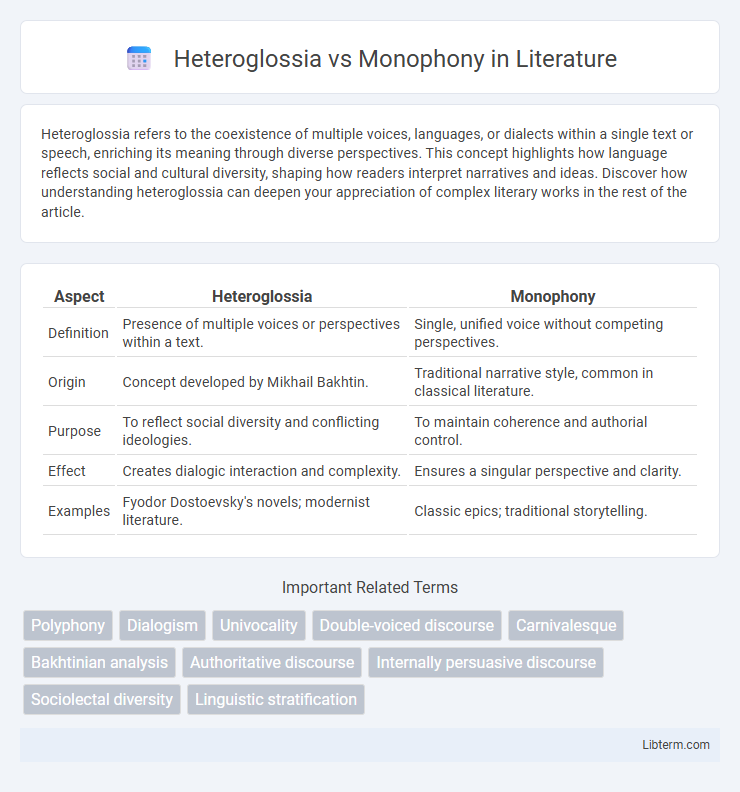Heteroglossia refers to the coexistence of multiple voices, languages, or dialects within a single text or speech, enriching its meaning through diverse perspectives. This concept highlights how language reflects social and cultural diversity, shaping how readers interpret narratives and ideas. Discover how understanding heteroglossia can deepen your appreciation of complex literary works in the rest of the article.
Table of Comparison
| Aspect | Heteroglossia | Monophony |
|---|---|---|
| Definition | Presence of multiple voices or perspectives within a text. | Single, unified voice without competing perspectives. |
| Origin | Concept developed by Mikhail Bakhtin. | Traditional narrative style, common in classical literature. |
| Purpose | To reflect social diversity and conflicting ideologies. | To maintain coherence and authorial control. |
| Effect | Creates dialogic interaction and complexity. | Ensures a singular perspective and clarity. |
| Examples | Fyodor Dostoevsky's novels; modernist literature. | Classic epics; traditional storytelling. |
Understanding Heteroglossia: Definition and Origins
Heteroglossia, a concept introduced by Mikhail Bakhtin, refers to the coexistence of multiple voices, styles, or points of view within a single text or discourse, reflecting social diversity and ideological contrasts. It originated from Bakhtin's theories on language and literature, emphasizing the dynamic, dialogic nature of communication where different voices interact and challenge each other. Unlike monophony, which represents a single, unified voice or perspective, heteroglossia highlights the polyphonic, layered complexity inherent in social language use.
Monophony Explained: A Singular Voice in Discourse
Monophony refers to a singular voice or perspective dominating a discourse, characterized by uniformity and the absence of multiple viewpoints. This concept contrasts with heteroglossia, where diverse voices and perspectives coexist, enriching the textual or conversational environment. Monophonic discourse often limits interpretive possibilities, emphasizing a centralized, authoritative narrative.
Historical Contexts of Heteroglossia and Monophony
Heteroglossia, a concept rooted in Mikhail Bakhtin's literary theory, reflects the coexistence of multiple voices, languages, and perspectives within a single text or discourse, emerging prominently in the study of novelistic forms during the early 20th century. Monophony, historically associated with medieval music and ecclesiastical chant traditions, represents a single melodic line without harmonic accompaniment, prevalent in Western Europe before the development of polyphony in the late Middle Ages. The historical contexts of heteroglossia and monophony highlight contrasting cultural developments: heteroglossia in literary modernism emphasizing dialogic interaction of social voices, and monophony in early music underscoring unified, singular expression in sacred settings.
Key Theoretical Differences Between Heteroglossia and Monophony
Heteroglossia refers to the coexistence of multiple voices, perspectives, or languages within a single text or discourse, emphasizing diversity and dialogic interaction. Monophony, in contrast, involves a single, unified voice or perspective, characterized by uniformity and lack of internal contradiction. The key theoretical difference lies in heteroglossia's embrace of social and linguistic multiplicity, while monophony represents ideological homogeneity and singular authority.
Heteroglossia in Literature: Multiple Voices and Meanings
Heteroglossia in literature refers to the coexistence of multiple voices, perspectives, and languages within a single text, creating a rich, layered narrative that challenges singular interpretations. This concept, developed by Mikhail Bakhtin, emphasizes the dynamic interplay of diverse social and ideological languages, allowing texts to reflect complex social realities and multiple meanings. Unlike monophony, which presents a single, unified voice or perspective, heteroglossia enhances literary depth by integrating conflicting viewpoints and cultural contexts, fostering reader engagement through interpretive openness.
Monophony in Writing: Characteristics and Examples
Monophony in writing features a single, unified voice or perspective, emphasizing clarity and consistency without the presence of multiple, conflicting viewpoints. This style is characterized by straightforward narration, limited internal dialogue, and an authoritative tone, often found in instructional texts, official reports, and classical lyric poetry. Examples include legendary epic poems like Homer's "The Iliad" and many traditional religious scriptures, where a singular narrative voice guides the reader.
The Role of Dialogue in Heteroglossic Texts
Heteroglossia emphasizes the coexistence of multiple voices and perspectives within a single text, enriching narrative complexity through dialogic interaction. Dialogue in heteroglossic texts functions as a site of ideological conflict and negotiation, revealing diverse social languages and value systems. This multiplicity contrasts with monophony, where a single authoritative voice dominates, limiting interpretive diversity.
Narrative Authority: Monophonic vs. Heteroglossic Approaches
Monophonic narratives centralize a single, authoritative voice that controls the story's meaning, reinforcing a uniform perspective and limiting interpretive divergence. Heteroglossic narratives incorporate multiple voices and viewpoints, creating a polyphony that challenges dominant interpretations and reflects social complexities. These contrasting approaches shape narrative authority by either consolidating a singular discourse or promoting dialogic interaction among competing voices.
Cultural and Social Implications of Heteroglossia
Heteroglossia, characterized by the coexistence of multiple voices and perspectives within a single cultural context, fosters inclusivity and diversity in social discourse, allowing marginalized identities to be expressed alongside dominant narratives. This dynamic interplay challenges monophony, where a single, unified voice dominates, often suppressing alternative viewpoints and reinforcing cultural hegemony. The cultural implications of heteroglossia promote dialogue, social change, and the democratization of language, transforming social structures through the recognition of plurality and difference.
Choosing Between Heteroglossia and Monophony in Modern Writing
Choosing between heteroglossia and monophony in modern writing hinges on the author's narrative goals and audience engagement strategies. Heteroglossia, characterized by the coexistence of multiple voices and perspectives, enriches text complexity and reflects social diversity, making it essential for works aiming to explore multifaceted realities or cultural dialogues. Monophony, with its singular, unified voice, enhances clarity and coherence, proving advantageous in genres prioritizing straightforward communication or thematic focus.
Heteroglossia Infographic

 libterm.com
libterm.com